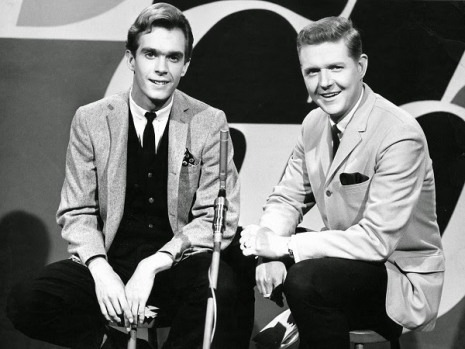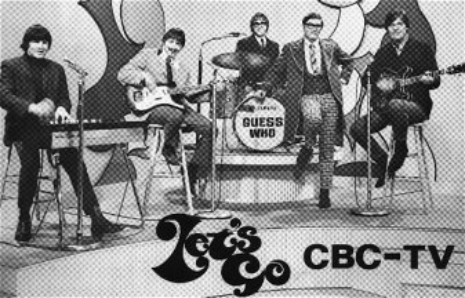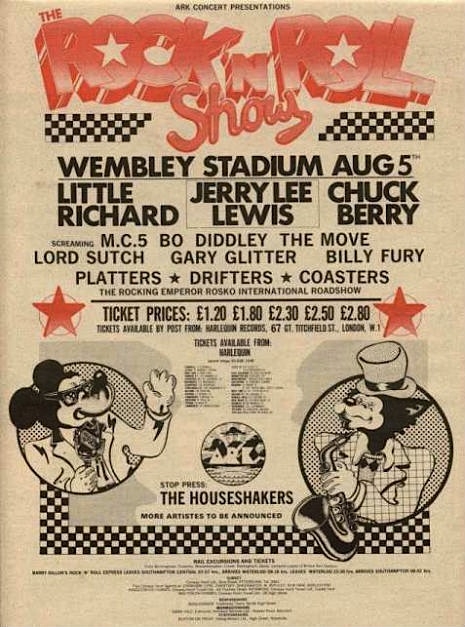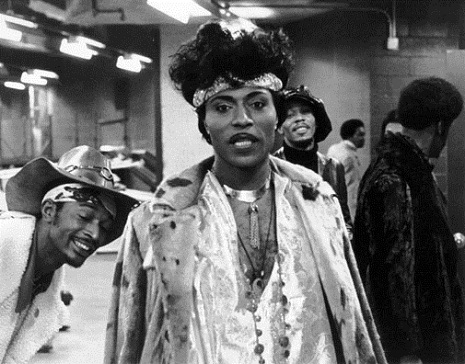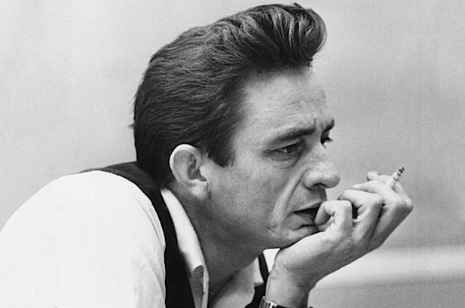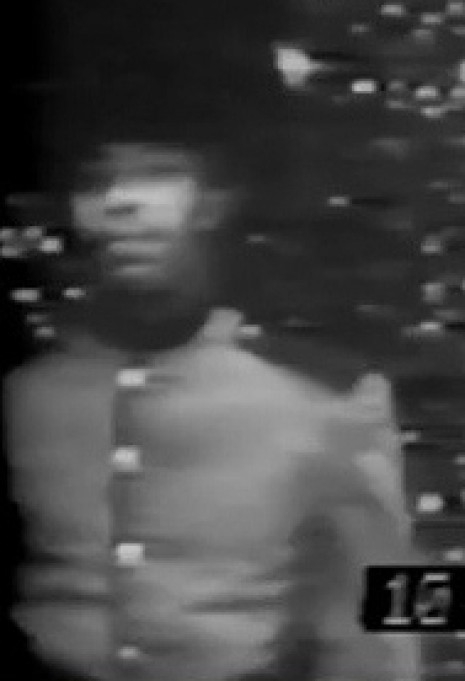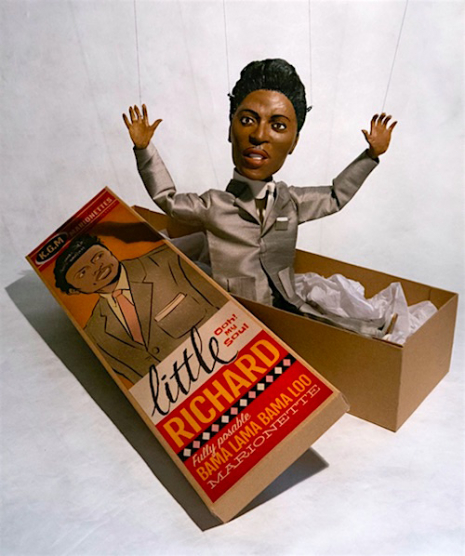
What have you been doing during the COVID-19 Lockdown?
Binging on boxsets? Drinking too much? Self-medicating? Finding all your good clothes have shrunk from lack of wear?
All of the above?
George Miller spent his time lockdown making a set of beautiful marionettes featuring some of the biggest stars of rock ‘n’ roll, country, and R&B.
Miller is a Glasgow-based artist, singer, musician and iconic pop figure who’s better known as the front man to the legendary Kaisers and more recently the New Piccadillys. I’ve known Miller a long, long time. Well, since he dressed like a rocker in a black leather jacket and sported a quiff like a zeppelin, combed back like a barrel most surfers would die for. Something like that, though memory is fickle.
Since then, Miller sang and played guitar with the Styng-Rites (“We got on telly once, made the independent top 20 once, got in the music papers a bit, built a cult following and gigged ourselves to exhaustion.”); played guitar with Eugene Reynolds’ band Planet Pop; then gigged with the Revillos and Jayne County and the Electric Chairs.
In 1993, Miller formed the Kaisers:
“We ended up making six albums and a bunch of 45s, toured the USA twice, Japan once and gigged all over Europe. We did John Peel and Mark Radcliffe sessions amongst others and got on the telly a few times. I think we lasted about seven years and everything we earned just about covered the bar bill.”
Most recently, Miller was involved with the New Piccadillys, worked with Sharleen Spiteri, then toured and recorded with Los Straitjackets across America. About five years ago, the Kaisers reformed due to public demand and will be releasing a new album in the fall—more on that another time.

George Miller: Portrait of the Artist as a Young Band.
I reconnected with Miller through social media. Over the past few months, he would post a photograph of his latest marionette in progress. Sculpting heads of rock stars like Little Richard, Jerry Lee Lewis, Chuck Berry and Buddy Holly or country greats like Johnny Cash. They were beautiful, fabulous models, which were then dressed by Ursula Cleary and placed in boxes designed by Chris Taylor.
How did these marionettes come about?
George Miller: I’d been working on a BBC children’s drama for a few weeks (I’m a freelance Production Designer, gawd help me) and as lockdown was approaching, production stopped so I went from super busy to completely idle pretty much overnight.
I’d made some marionettes for a video a few years earlier and since then had been toying with the idea of making one of Link Wray but never seemed to have the time, so lockdown seemed the ideal opportunity. I liked the notion of spending time making something that had no ultimate purpose other than self amusement and no deadline for completion. With his outfit made by my partner Ursula, Link turned out pretty satisfactorily but after a few days I got the itch again, so I got to work on Bo Diddley, another guitar favorite of mine. Bo gave me a bit of trouble and the first attempt went in the bin. Realizing I’d tried to rush it, I reverted to lockdown pace, which I’ve employed ever since.
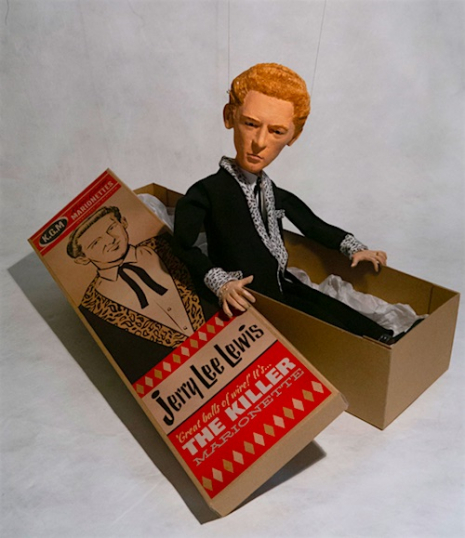
Why did you choose the classic rock ‘n’ roll, R’n'B icons?
GM: I wouldn’t call myself a musical luddite, but nothing has ever thrilled me more than a good rock ‘n’ roll record, so I decided to keep making favorites from the 1950s until my day job resumed. Although a couple of the subjects are still with us, the notion of “resurrecting” the others in some way appealed to me. I like seeing them bursting out of their “coffins.” It’s also a way of expressing my fascination with these people and the music they made. If I start to run out of subjects, I’ll move forward in time, but I doubt I’ll go past 1965 as the joy goes out of it a bit for me around then.
Maybe I’ll fast forward—Joey Ramone would be a good subject.
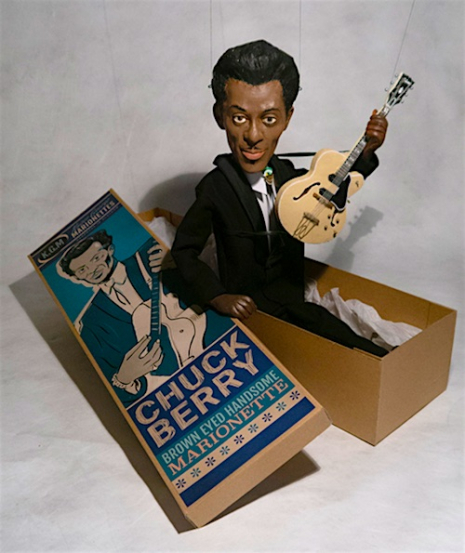
Where did the boxes for the marionettes come from?
GM: When I posted a photo of the Buddy Holly puppet, a Facebook friend by the name of Chris Taylor sent me a mock-up of a box label with a great illustration and excellent graphics. Chris got me thinking that this could be a “proper” project and we’ve been working together on ideas for an exhibition and a range of merchandise, as the marionettes have been developing a bit of a virtual fan base online. Chris’s illustrations have a great deal of style and though instantly recognizable, they have their own identity, which complements the puppets which are more rigidly representational. It reminds me of opening a box to find that the toy inside looks different to the illustration, something that always registered with me as a child. Chris’s work has definitely steered things in the direction of an art project, albeit with the (for now) all-important absence of deadline.
Where can we buy these Kaiser George Marionettes?
GM: The marionettes are one-offs and aren’t for sale as they take so long to make. I wouldn’t want to sculpt any of them twice, though mould making could be an option. As someone commented on Facebook, it would be a bit like selling your children. Chris and I are working on a set of bubblegum cards which will be for sale and we’re unashamedly excited about it. Second childhood? Definitely.
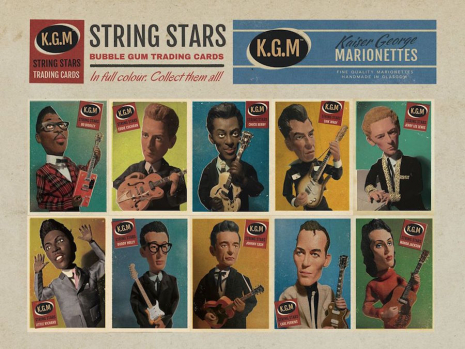
KGM Trading Cards.
What other plans do you have for your rock ‘n’ roll children?
GM: When the “cast” of puppets grows to 20 or so, I’m planning on making a video showcasing their individual musical styles plus a series of short clips based on the photographs of Gene Vincent and Eddie Cochran passing time in the dressing room of the Glasgow Empire theater. I quite like the idea of two marionettes in a small room not doing very much, just idle movements.
Now, if I was an enterprising businessman, I would certainly be thinking of investing in mass marketing these to-die-for Kaiser George Marionettes. You know you sure as hell want one. And damned if I wouldn’t be collecting all those trading cards too.
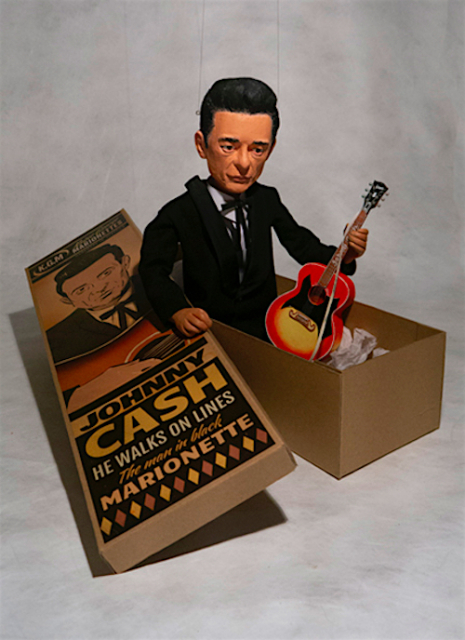
See more of George’s Marvellous Marionettes, after the jump…






